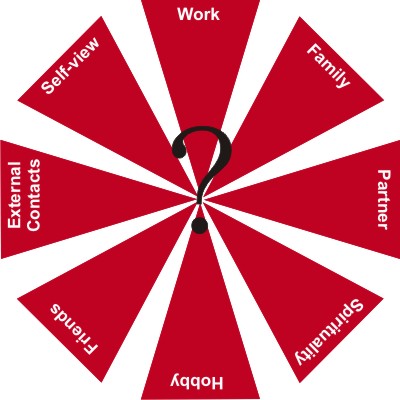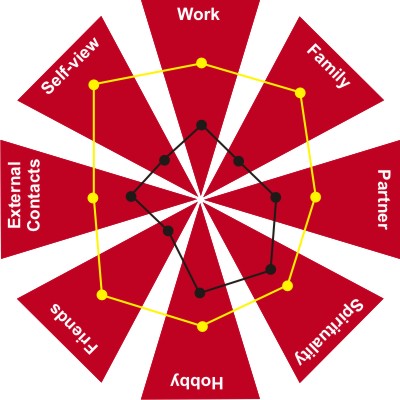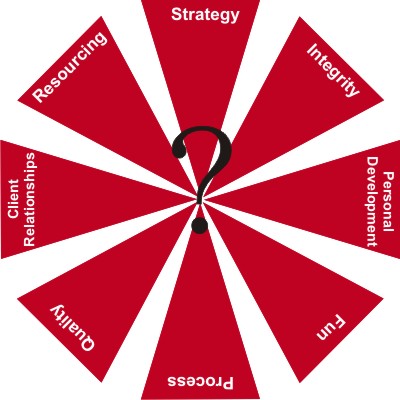Covey’s Seven Habits for the Digital Agency – Habit 2 (part 2): Finding and keeping your centre
What would you consider your centre? Where are your values focused and from where do you draw your security, guidance, wisdom, and power? These are questions Covey asks and we ask ourselves in the studio we work through in the second part of Habit 2: Keeping the End in Mind.

As we worked through the concept in a recent breakfast session, one of the team astutely mentioned that what we can consider our centre is not any one thing, but often varying degrees of many aspects of our identity that we claim as our centre. I don’t disagree with this in practice, but I find myself wondering if we can have a centre that is distinct from any one spoke. Without a spoke-exclusive centre, what we claim as our centre can cause our wheel to become quite unbalanced.
A simple exercise to self-assess your centre is to write down what you feel your “spokes” are in one column. Then in two other columns, write a number for how “centred” you feel under no stress and a number for how you feel under high stress with 1 being no stress and 10 being high-stress. Finally, draw out your spokes and plot both circles.
| Spoke | Low-stress | High-stress |
| Work | 3 | 6 |
| Family | 2 | 7 |
| Partner | 3 | 5 |
| Spirituality | 4 | 5 |
| Hobby | 4 | 5 |
| Friends | 2 | 7 |
| External contacts | 3 | 5 |
| Self-view | 2 | 8 |

The results of this process can reveal two things. First, deviations along a specific spoke in your low and high stress points may reveal what is not your centre. Second, if the two circles overall are of significantly different shape, it may show you are not operating under a principle-based centre.
Different spokes for different folks
I will grant that this process is played out differently based on personalities and natural tendencies to respond to stress. Everyone’s spokes may also be different, as some may operate from a principle-based centre in many areas with notable exceptions of specific spokes. Finally, there are those who say a certain spoke should be your centre, such as “family” or “spirituality”.
Unfortunately, I have seen too often where the constructs of religion or dysfunctional family relationships (rather than the healthy expressions) can pervert what was originally intended as a healthy centre. Rather, I ask if there is a centre that incorporates the many aspects of who you are, but is also independent such that your centre is not blown away when you are under pressure. I ponder such a centre as I look at the significant pressures facing today’s digital studio.
The approach described above can be applied to any organisation, replacing the personal spokes with organisational attributes. In the studio, natural pressures are prevalent. Clients move deadlines, project schedules cause conflict in resource allocations, and unforseen programming challenges can increase development time. By the same token, I strive to continuously improve aspects such as quality, processes, strategy, research and development, and fun and culture.

As the pressures increase, I note how the degree to which stress impacts my ability to move these areas forward can vary from mild to significant, depending on the area. I will leave you with two solutions I strive to apply in our studio:
1) Find a principle-based centre for the organisation
When the pressure is on, confirm who are you as a group of people and remind yourself of your common goal outside of your immediate concerns. This ties into how we address the gap between stimulus and response through knowing who you are.
2) Find those who are not as impacted under stress to support your weak spokes
Everyone reacts differently under stress. Some may be able to continue to see the strategic vision, others can focus on process, while others have the capacity to keep the laughs happening under fire. Know the strengths of your team, and apply grace and understanding to those whose spokes need supporting.

The diagram on Finding your Center. Once you have plotted the high and low points, how do you interpret it. It looks great, but I don’t know what it means.
Hi Allen,
Good question! Looking at the spokes will tell you two things:
First is to help identify what areas of your life you may be experiencing the most stress in your life. It can help to see where the high numbers are at.
Second is areas wheres you may be better at managing that stress. This is the gap between the two measures. For example, a person’s workplace may have high conflict that they may be handling better than conflict in personal relationships, they may be using work as an avoidance mechanism, or their homelife may be a source of strength and stability for a challenging workplace. The concern is when there are gaps all around the ring.
Finally, the tool can be used as an input to a broader assessment of identity gaps. We each have several forms of identity we maintain. One consideration of identity is the concept of identity markers, such as parent, employee, manager, etc. Within each of these markers, we also have different concepts of identity, such as our actual and idealised selves. Stress can be introduced when there is incompatibility between identity markers (an artist who’s day-job is largely managerial and non-creative in the aesthetic sense) and between our concepts of identity (a leader plagued by insecurities, refer to impostor syndrome).
Hope that helps, and thanks for the question!
Chad